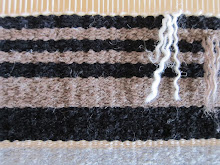
Bread & Puppet performing in S. Royalton, VT
Last week we finally got to see Bread & Puppet do a live performance. I have heard about them over the years, and last summer Mark and I drove to Glover on a day they were scheduled to perform, but we hadn't checked times and were too early, though we did see the museum and some of the preparations for the evening performance. This time we only had to go to South Royalton, which was convenient since we wanted to do grocery shopping too. It was clear that the performers were having as much fun as the audience, probably even more fun. Who wouldn't enjoy walking on those stilts?

Peter Ziek, Prentis House, and chair at Shelburne Museum
My brother, Peter Ziek, came for a visit last week. He is taking web design and Photoshop at the community college in Colorado Springs, and we spent one morning sitting side by side at my desk with our computers open to Photoshop, going over some things. He is color blind--and it was really interesting watching what he was doing. At one point he was modifying the color of his son's hair in one picture--trying to make it red but it sure looked like purple to me. It is hard enough to try to figure out color for a website, since you have no idea how one person has set their monitor versus your monitor's setting, but to try to do this when you don't see color the way other people do is really daunting.
I did learn something new by working with him. Usually when I want to make a collage of images, I open up the various images, then drag them into another image, creating layers by the move tool. Looking through menus, trying to find a template option (we think he got this from a different program), I saw "Place" under the File Menu. Trying it I found that I could just use that to bring various images into one file, each on its own layer. I always like how Photoshop has several ways to do the same thing, and when writing The Woven Pixel, Alice Schlein and I tried to give variations of method in the book, so readers would be encouraged to explore and find methods that worked for them, rather than sending everyone always down the same path.
Friday was raining, but Mark and Peter and I drove up to Burlington to the Shelburne Museum anyway. Since reading about the Kalkin House in Dwell Magazine, I have wanted to see this building, designed by Adam Kalkin, made out of a Butler Building shell and shipping containers. Right now the museum is having an exhibit of work by Richard Saja in the Kalkin House. Though I liked his central "animal chandelier" (like an early Mike Kelley), I was unimpressed by his jacquard weaving and other textiles. I think it would have been more interesting to see some of the furnishings found in the older buildings at the museum placed in this contemporary modular building. Perhaps I would have like Saja's work better too, if it had been placed in one of the older buildings, so his style would contrast more with the architecture.

Kalkin House at Shelburne Museum
Shelburne Museum was founded by Electra Havemeyer Webb in 1947. She seems to have collected everything, and wherever I looked I found another image of repeat pattern to capture with my digital camera. When we were leaving, someone in the bookstore asked me what I liked best in the museum. By then my head was dull, from seeing so many things and I couldn't think of an answer. But I did enjoy Barbara Richart's demonstration of the jacquard loom (she was so small compared to the loom and she had to lift the threads in a two part sequence--first stepping on the treadle to lock the hooks, then almost jumping on the treadle to life the threads), and I loved how the view through one old window looked just like it had been created with a Photoshop filter.

Repeat Pattern as seen at Shelburne Museum
(blueberries from Sunshine Valley Berry Farm)

Barbara Richart demonstrating the jacquard loom

Old window at Shelburne Museum
Saturday my family gathered in Stockbridge, MA to celebrate the 100th birthday of my Aunt Bess (Bess Shubin). It was a lovely event, and I have posted a slideshow of the images I took for my family (and anyone else interested) to see. Just click here. I am sorry that I didn't manage to get pictures of everyone, but there were so many cameras flashing and clicking, I am sure others got a better record of the event. Bess is the first in our family to reach 100--and as you can see, she is fully-present and with us. I especially liked seeing her with her granddaughter Leah's children--her great grandchildren.

Aunt Bess holding the cake weaving I made for her

Bess Shubin cutting her cake, flanked by two of her great grandchildren



























